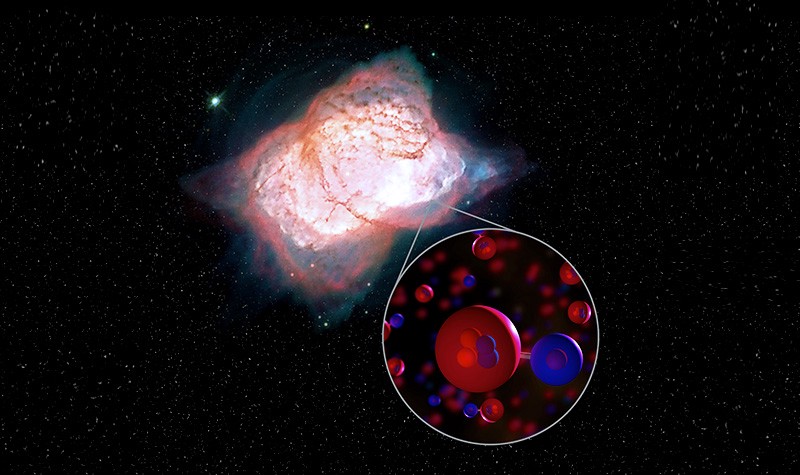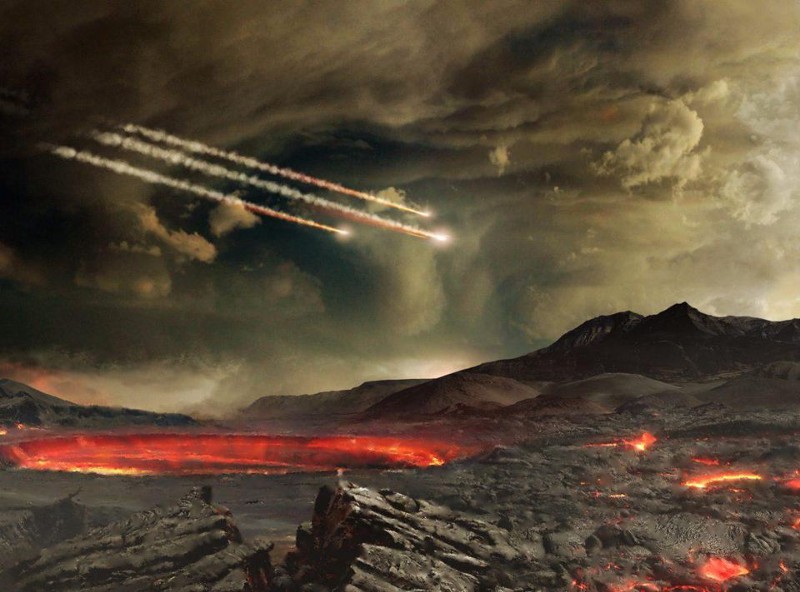The radical quest to discover how the first molecules of life arose

- In the early 20th century, a young Russian biochemist had a radical idea: That chemical evolution could explain the origin of life.
- The biochemist, named Alexander Oparin, launched the first scientific effort to determine how the atoms and particles, which we now know were created in the Big Bang, made the molecules of life.
- In his book What's Gotten Into You: The Story of Your Body's Atoms, from the Big Bang Through Last Night's Dinner, Dan Levitt explores the fascinating history of this search, as well as the science behind the origins of life as we know it.
In 1918, the citizens of Moscow, the new capital of Communist Russia, struggled to maintain a semblance of normal life. It wasn’t easy. A brutal civil war between the White and Red Russian armies was raging. The West had imposed a trade war. The capital was aswirl with revolutionary ideas, new ways of thinking about equality, justice, and history. Those of means who had not fled were demoted to ordinary citizens and forced to share their wealth and homes with the less privileged. Despite all the revolutionary fervor, Alexander Oparin, a young biochemist steeped in radical scientific ideas, received disappointing news. The censorship board would not permit him to publish a manuscript that speculated on how life arose from mere chemicals. Though the Bolsheviks had overthrown the tsar a year ago, their revolutionary ideology had not yet filtered down to the censors, perhaps because they were not yet ready to directly antagonize the Russian Orthodox Church.
Nonetheless, Oparin’s radical ideas would not be suppressed long. They would spark a quest to find the origin of our ancient chemical ancestors—the organic molecules that are the building blocks of life. It would be the first step, he hoped, of an effort to tie “the world of the living” to “the world of the dead.”
He would launch the first scientific effort to determine how the atoms and particles, which we now know were created in the Big Bang, made the molecules of life.
Oparin grew up in Uglich, a country town of traditional log houses, dirt roads, and horse-drawn carriages. A budding plant collector, he delighted in the fantastic variety of trees, grasses, flowers, and insects he found in the forests of spruce, birch, and pine. In 1914 he enrolled in Moscow University to study botany, and in 1917, the year the Bolsheviks seized power, he took up graduate studies in plant physiology. He adopted a Lenin-like goatee and mustache, and began working with the distinguished scientist and revolutionary Alexei Bakh, whose scathing, widely read pamphlet, Tsar Hunger, had popularized revolutionary socialism. Under Bakh, Oparin studied photosynthesis in algae.
The more he learned, the more he was convinced of another revolutionary idea: that chemical evolution could explain the origin of life. Even half a century after Darwin published The Origin of Species, few others agreed. In England, many prominent scientists had long been men of the cloth who regarded their mission as revealing the majesty of God’s creation. It was heretical to suggest that life could arise from inanimate chemicals. But in the new Russia, Oparin’s speculation along these new lines was positively encouraged (although not yet by the censorship board).
Still, in trying to retrace our chemical origins, Oparin faced a glaring problem: the molecules in your body and all life are entirely different from the inorganic ones found in the rocks around us. If you analyzed your composition, you’d find that about 60 percent of you is water. Another 1 percent is ions—charged molecules made of elements like sodium, potassium, and magnesium. Everything else within you, from your fingernails and skeleton to your muscles and brain, is fashioned from organic molecules—molecules built around chains or rings of carbon.
If carbon has a personality type, it’s an extroverted connector. In fact, if we ever discover life elsewhere in the universe, many scientists believe that it too will be built around carbon. Carbon’s versatility stems from the fact that it has four electrons in its outer shell. That, and its small size, means that through neat tricks of geometry it can bond easily in four directions, creating long, stable rings and chains. These are the backbones of your organic self. Your sugars, fatty acids, amino acids, and nucleic acids are all built around carbon. When these link together, they make carbohydrates, fats, proteins, and DNA— your larger organic building blocks. Your heart, for instance, a large muscle, is about 70 percent protein (not counting the water)—in other words, 70 percent amino acids.
As far as scientists knew, however, these organic molecules could be made only by living things. You won’t find them in Earth’s rocks, no matter how long you search—except in sedimentary rocks, like coal, that were created from organic matter. That posed an obstacle to explaining the origin of life, to put it mildly. You couldn’t very well understand its appearance if you didn’t know where its building blocks came from. Scientists were baffled. The gulf between the inorganic molecules in dead rocks and the complex organic ones in life was as problematic to scientists then as explaining how the molecules in our brains create consciousness is today. Many believed that organic molecules could be created only by a “vital spark”—an inexplicable force found only in living organisms.
When I was a student, I always thought vitalism was ridiculous. How could any scientist put stock in it? But it’s easier to understand if you walk in scientists’ shoes. As far back as Aristotle, many great thinkers believed in a form of vitalism. If you had no theory of how simple molecules became organic ones, no powerful electron microscopes to visualize cells or the structures within them, and no idea how heredity was transmitted, then the leap from dead chemicals to living creatures might appear magical. Consider this: If you break a stone in half, nothing further will happen to either piece. If you slice a planarian flatworm in half, both sections will regenerate into identical wholes. How do you explain that? “In living Nature, the elements seem to obey different laws than they do in the dead,” wrote the eighteenth-century Swedish chemist Jöns Berzelius. Inanimate matter appeared to lack a life energy. The brilliant nineteenth-century physicist Lord Kelvin (also known for opining that heavier-than-air flying machines could never be possible) wrote, “Dead matter cannot become living without coming under the influence of matter previously alive. This seems to me as sure a teaching of science as the law of gravitation.” In the twentieth century, Niels Bohr, a founder of quantum physics, speculated that we might need to discover new types of physical phenomena to understand life. Even Darwin himself, who had shown how new species arose, was at a loss to explain how the first life sprang from a pool of chemicals. “It is mere rubbish thinking at present of the origin of life,” he wrote to the botanist Joseph Hooker. “One might as well think of the origin of matter.”
Many nineteenth-century scientists were so frustrated that they punted. Lord Kelvin’s solution was to propose that the universe and life had always existed. The famed scientist and philosopher Hermann von Helmholtz was of the same opinion. Life was immemorial, they believed—as old as matter itself. It must have existed elsewhere in the universe long before it turned up on Earth. How it found its way here remained a mystery, although they speculated that it might have hitched a ride on meteors or comets. “Who knows,” Helmholtz argued, “whether these bodies, which everywhere swarm through space, do not scatter germs of life wherever there is a new world?” But the theory of panspermia (meaning “seeds everywhere”), which Kelvin, Helmholtz, and others proposed, merely kicked the can down the road. It did nothing to help unravel the mystery of life’s origins.
In 1922, some years after Oparin’s rejection by the censorship board, he was working in a Moscow laboratory with his Bolshevik hero, Alexei Bakh. He also received a teaching appointment. He would long be remembered for the imposing, incongruous figure he cut at the university. He had been sent abroad to study briefly, and in contrast to his students’ worn, shabby clothes, he wore a sharp European suit, always with a bow tie, which bestowed a note of elegance and authority. Living conditions were tough in the new worker’s paradise. The economy was in tatters, and many in Moscow were starving. Oparin began applying his biochemical knowledge to improve the production of bread and tea.
Even in this time of great need, though, he couldn’t shake his fascination with deeper scientific questions. He too recognized that Darwin’s masterpiece, On the Origin of Species, was “missing its very first chapter,” but Oparin thought something could be done about it. He decided to return to first principles. Was it really possible that organic molecules could be made only by living organisms? If so, then the very first cell—the first membrane-enclosed collection of molecules able to produce energy and replicate—must have been so fantastically sophisticated that it could also manufacture the very materials of which it was made. Clearly, this was much too great an evolutionary jump to contemplate. To Oparin, it made much more sense to presume that the first cell arose from organic molecules that already existed around it. But where did they come from?
He already knew one fact that makes the origin of life appear deceptively simple. Nineteenth-century chemists had already established that, despite the large number of elements in the periodic table, almost all of our mass comes from just six of them: carbon, hydrogen, oxygen, nitrogen, sulfur, and phosphorus.
Your fats and carbohydrates are chains of molecules made exclusively of carbon, hydrogen, and oxygen. Your proteins are built from carbon, hydrogen, oxygen, nitrogen, and sulfur. And your DNA is made only of carbon, hydrogen, oxygen, nitrogen, and phosphorus. Those six elements compose roughly 99 percent of everything within you. A 150-pound person contains by mass 94 pounds of oxygen, 35 pounds of carbon, 15 pounds of hydrogen, 4 pounds of nitrogen, almost 2 pounds of phosphorus, and a half pound of sulfur.
Those six elements also happen to be among the most plentiful in the universe. Hydrogen is the most abundant of all; oxygen is third; carbon, sixth; nitrogen, thirteenth; sulfur, sixteenth; and phosphorus, nineteenth. In one sense, that makes understanding the origin of life a game of chemical Scrabble. You simply have to explain how those few elements combined to make organic molecules.
Of course, that turns out to be devilishly difficult. Atoms are picky about whom they bond with. And the number of potential combinations of these six elements is mind-boggling. Carbon is so promiscuous, so talented at contorting and bonding, that there are more than ten million organic molecules known on Earth.
In 1924, in a Red Russia now eager to convince the populace that God did not exist, Moscow Worker published Oparin’s seventy one-page manuscript as a pamphlet, with “Proletarians of the World Unite!” splashed across its front cover. Twelve years later, Oparin published a book that expanded his argument and incorporated more recent science.
Oparin’s first groundbreaking insight was that, to understand how life first arose, he needed a clear picture of the Earth billions of years ago. Curiously, almost no one thinking about life had considered that before. After reviewing the latest findings in astronomy and geology, he realized that when Earth first formed, it looked nothing like it does today.
Most important was what it lacked. Many scientists assumed that oxygen had always been present, but Oparin understood that the oxygen in our atmosphere was produced by photosynthesis. Our atmosphere had no oxygen before life arose. You and I couldn’t have survived there for a second.
He claimed that the Earth’s early atmosphere was more like Jupiter’s, which astronomers had just discovered was full of ammonia and methane. Remarkably, from basic ingredients—simple hydrocarbons, such as methane (CH4 ), along with ammonia (NH4), hydrogen (H2), and water (H20)—Oparin outlined on paper a detailed series of chemical reactions that might create more complex organic molecules, proteins, and life. Life, he argued, could be understood as the culmination of chemical evolution. Modestly, he titled the book The Origin of Life, a fitting name for a prequel to Darwin’s On the Origin of Species.
What did that first life look like? Some of Oparin’s contemporaries claimed that it was photosynthesizing algae. To Oparin, that was patently impossible. As a plant biochemist, he had a healthy appreciation for the complexity of photosynthesis. There was no way that the first organisms to evolve were already so sophisticated; that was too much of an evolutionary leap. Instead, for the first life-form, he nominated clusters of organic molecules in the ocean that slowly evolved into bacteria.
In England, the flamboyant freethinking evolutionary biologist, biochemist, mathematician, and prolific author J.B.S. Haldane developed a similar theory independently, which appeared in a journal, the Rationalist Annual. Many scientists dismissed it at first as “wild speculation,” and Haldane largely moved on to other weighty matters. But Oparin continued to work on the origin of life for the rest of his career. Oparin’s contribution to science was not just groundbreaking—it would set off a scientific explosion.





